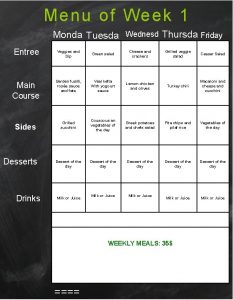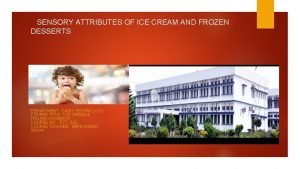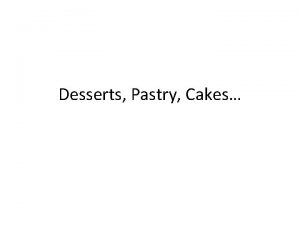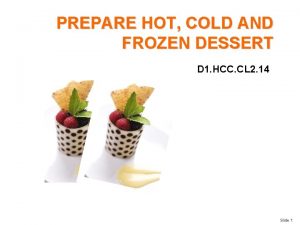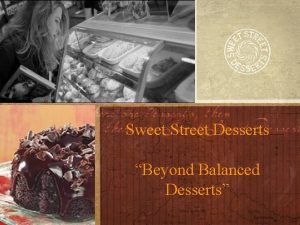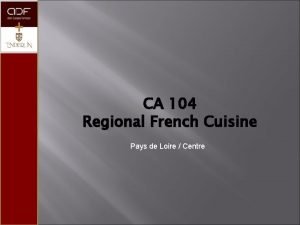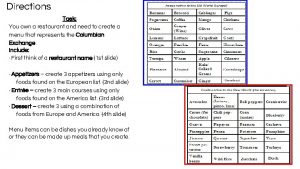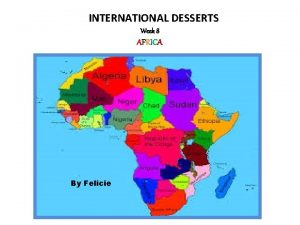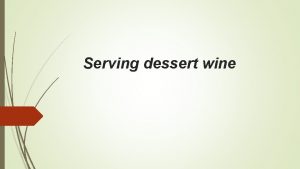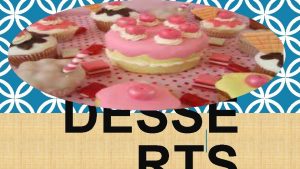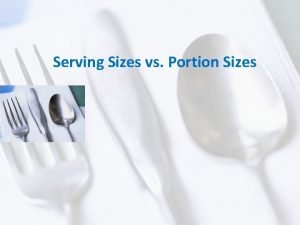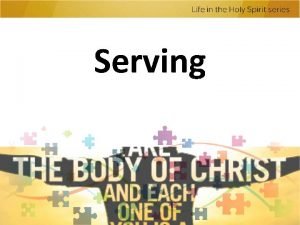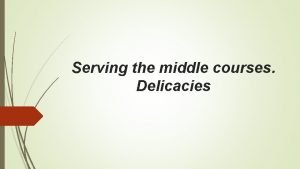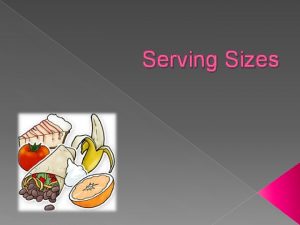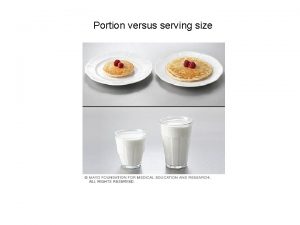Serving desserts Dessert is a course that typically



















- Slides: 19

Serving desserts

Dessert is a course that typically comes at the end of a meal, usually consisting of a sweet food but sometimes of a strongly-flavored one, such as some cheeses. The word comes from the Old French desservir, "to clear the table. " Many people, regardless of the meal service, would expect the table to be cleared of nearly all dishes before the dessert is presented. Some common desserts are cakes, cookies, fruits, and candies. Other terms for dessert are “sweets”, “pudding”, and “afters”.

The dessert course is served on a small appetizer plate with a dedicated dessert spoon or fork.

This course usually consists of a slice of cake, pie, or other sweet dish and a glass of dessert wine.

However, some people prefer to serve cheese and crackers instead of dessert.

We eat with our eyes first, so it’s important to learn how to plate desserts properly. Prettily presenting your desserts is a cooking technique that makes for a pleasing visual feast before the spoon or fork is even picked up.

Pastry chefs in restaurants take great pains to plate desserts so that they look as good as they taste, considering their composition much as master painters would consider how to arrange their canvas.

BE CREATIVE WITH COLOR. A splash of color can bring your desserts to life. A lemon tart goes from a monotone palette to lively and lovely when presented with the contrast of a violet flower and marbled raspberry coulis.

COMBINE TEXTURES. Adding different textures to the plate adds excitement to the visual appeal of dessert course. The different textures excite the senses. For example, pairing a smooth, rich ganache with cookie crumbs and soft marshmallows adds just enough “busyness” to draw the eye in to the dessert.

COMPOSE YOUR PLATE AS YOU WOULD A PAINTING. There are many ways to compose a plate. Consider the plate as if it were a blank canvas or as if you were composing the frame for a photograph.

CONSIDER THE VESSEL. It may seem like common sense, but consider the experience of eating the dessert when you choose the type of plate. Don’t serve it on a too-tiny plate which may have garnish popping off and on to the table once the tines of a fork hit the dessert. If your dessert is creamy, it’s going to be easier to access in a rounded container or bowl.

CONTRAST TEMPERATURES. There’s nothing like pairing a slice of perfectly prepared pie or a fruit tart with a cool slice of ice cream. Combining temperatures can be a beautiful thing. Do not put your dessert on a hot plate. Ice cream will melt too rapidly, obviously, but other desserts may “wilt” too. A slightly chilled plate may be helpful when plating cold desserts, whereas room temperature will do just fine for most cakes or pies.

HAVE A FOCAL POINT. Using an element in your dessert as a focal point can help give your plating focus.

LET IT BE DRAMATIC. Have a little fun with your dessert. Employ tricks to add some magic to the presentation. People enjoy a little pomp with their meal, and it’s fun to have your dessert course greeted with “Wow, how’d you do that? ”

DON’T MAKE IT TOO TALL OR WOBBLY. A slice of layer cake looks fantastic standing up on a plate. But if it’s too tall, there’s a strong chance of it toppling over even on a short journey to where it is being served. If it seems too tall or wobbly, it probably is. While many dessert professionals adore the visual of serving a slice of cake upright, the general consensus is that if you’re in doubt, lay it on its side.

GARNISH WITH CARE. Random mint leaves or raspberries for artful effect? Forget it; it’s more likely to be confusing than anything else. Keep in mind how the garnish will function on the finished plate.

BE CONSISTENT. When plating desserts for a crowd, be consistent in your design and in serving size. It can be confusing to see different presentation on each plate, and nobody likes looking over to the plate across the table and seeing a serving double the size

Common desserts: Trifle - sponge cake soaked in fruit juice or sherry, layered with fruit salad and custard. Trifle may be decorated with whipped cream, glace cherries or nuts. Basic meringue - a light foamy mixture of whipped egg white and caster sugar, which is baked in the oven and served cold. Fruit based - fruit is the main ingredient Jellies - gelatin is used to set these fruit flavored desserts or as a glaze on fruit tarts. Molded creams - a cold custard cream is mixed with other flavors to form the basis of a molded dessert.

Egg custard - milk is thickened with egg yolks to form firm custard when baked. Pancakes and crepes - a basic batter mixture, which when panfried, can be served with a sauce or filling. Sponge based - desserts which have a sponge base can be steamed or baked and can be flavored with a variety of ingredients including chocolate, jam, honey, lemon, orange, cheese, fruit pulp, or a syrup. Pies and tarts - pastry cases filled with fruit or nuts. Egg based - these desserts use an egg or egg custard base, e. g. puddings, bread pudding. Soufflés - these desserts are based on a firm meringue base and may incorporate chocolate, fruit or cheese; further flavored with alcohol or vanilla.
 1 entree
1 entree Tôn thất thuyết là ai
Tôn thất thuyết là ai Phân độ lown ngoại tâm thu
Phân độ lown ngoại tâm thu Walmart thất bại ở nhật
Walmart thất bại ở nhật Gây tê cơ vuông thắt lưng
Gây tê cơ vuông thắt lưng Block nhĩ thất độ 2 mobitz 1
Block nhĩ thất độ 2 mobitz 1 Tìm độ lớn thật của tam giác abc
Tìm độ lớn thật của tam giác abc Sau thất bại ở hồ điển triệt
Sau thất bại ở hồ điển triệt Thể thơ truyền thống
Thể thơ truyền thống Hãy nói thật ít để làm được nhiều
Hãy nói thật ít để làm được nhiều Thơ thất ngôn tứ tuyệt đường luật
Thơ thất ngôn tứ tuyệt đường luật Macaroons in kenya
Macaroons in kenya Frozen desserts characteristics
Frozen desserts characteristics Pictures of desserts
Pictures of desserts Wikipedia
Wikipedia Hot and cold dessert ppt
Hot and cold dessert ppt Sweet streets desserts
Sweet streets desserts Pays de la loire food
Pays de la loire food Old world desserts columbian exchange
Old world desserts columbian exchange Desserts in africa
Desserts in africa
